Huynh Thi Thanh Binh
HSEvo: Elevating Automatic Heuristic Design with Diversity-Driven Harmony Search and Genetic Algorithm Using LLMs
Dec 19, 2024



Abstract:Automatic Heuristic Design (AHD) is an active research area due to its utility in solving complex search and NP-hard combinatorial optimization problems in the real world. The recent advancements in Large Language Models (LLMs) introduce new possibilities by coupling LLMs with evolutionary computation to automatically generate heuristics, known as LLM-based Evolutionary Program Search (LLM-EPS). While previous LLM-EPS studies obtained great performance on various tasks, there is still a gap in understanding the properties of heuristic search spaces and achieving a balance between exploration and exploitation, which is a critical factor in large heuristic search spaces. In this study, we address this gap by proposing two diversity measurement metrics and perform an analysis on previous LLM-EPS approaches, including FunSearch, EoH, and ReEvo. Results on black-box AHD problems reveal that while EoH demonstrates higher diversity than FunSearch and ReEvo, its objective score is unstable. Conversely, ReEvo's reflection mechanism yields good objective scores but fails to optimize diversity effectively. With this finding in mind, we introduce HSEvo, an adaptive LLM-EPS framework that maintains a balance between diversity and convergence with a harmony search algorithm. Through experimentation, we find that HSEvo achieved high diversity indices and good objective scores while remaining cost-effective. These results underscore the importance of balancing exploration and exploitation and understanding heuristic search spaces in designing frameworks in LLM-EPS.
Active and Passive Beamforming Designs for SER Minimization in RIS-Assisted MIMO Systems
Oct 08, 2024Abstract:This research exploits the applications of reconfigurable intelligent surface (RIS)-assisted multiple input multiple output (MIMO) systems, specifically addressing the enhancement of communication reliability with modulated signals. Specifically, we first derive the analytical downlink symbol error rate (SER) of each user as a multivariate function of both the phase-shift and beamforming vectors. The analytical SER enables us to obtain insights into the synergistic dynamics between the RIS and MIMO communication. We then introduce a novel average SER minimization problem subject to the practical constraints of the transmitted power budget and phase shift coefficients, which is NP-hard. By incorporating the differential evolution (DE) algorithm as a pivotal tool for optimizing the intricate active and passive beamforming variables in RIS-assisted communication systems, the non-convexity of the considered SER optimization problem can be effectively handled. Furthermore, an efficient local search is incorporated into the DE algorithm to overcome the local optimum, and hence offer low SER and high communication reliability. Monte Carlo simulations validate the analytical results and the proposed optimization framework, indicating that the joint active and passive beamforming design is superior to the other benchmarks.
Phase Shift Design for RIS-Aided Cell-Free Massive MIMO with Improved Differential Evolution
Aug 12, 2023Abstract:This paper proposes a novel phase shift design for cell-free massive multiple-input and multiple-output (MIMO) systems assisted by reconfigurable intelligent surface (RIS), which only utilizes channel statistics to achieve the uplink sum ergodic throughput maximization under spatial channel correlations. Due to the non-convexity and the scale of the derived optimization problem, we develop an improved version of the differential evolution (DE) algorithm. The proposed scheme is capable of providing high-quality solutions within reasonable computing time. Numerical results demonstrate superior improvements of the proposed phase shift designs over the other benchmarks, particularly in scenarios where direct links are highly probable.
HabiCrowd: A High Performance Simulator for Crowd-Aware Visual Navigation
Jun 20, 2023



Abstract:Visual navigation, a foundational aspect of Embodied AI (E-AI), has been significantly studied in the past few years. While many 3D simulators have been introduced to support visual navigation tasks, scarcely works have been directed towards combining human dynamics, creating the gap between simulation and real-world applications. Furthermore, current 3D simulators incorporating human dynamics have several limitations, particularly in terms of computational efficiency, which is a promise of E-AI simulators. To overcome these shortcomings, we introduce HabiCrowd, the first standard benchmark for crowd-aware visual navigation that integrates a crowd dynamics model with diverse human settings into photorealistic environments. Empirical evaluations demonstrate that our proposed human dynamics model achieves state-of-the-art performance in collision avoidance, while exhibiting superior computational efficiency compared to its counterparts. We leverage HabiCrowd to conduct several comprehensive studies on crowd-aware visual navigation tasks and human-robot interactions. The source code and data can be found at https://habicrowd.github.io/.
A bi-level encoding scheme for the clustered shortest-path tree problem in multifactorial optimization
Feb 12, 2021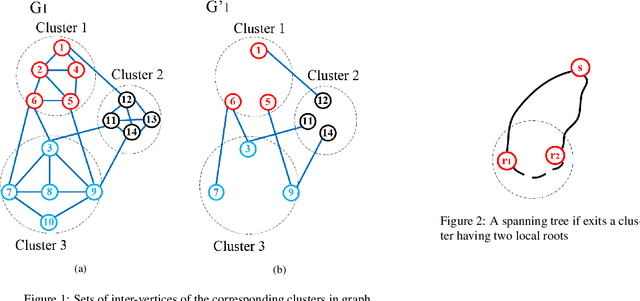

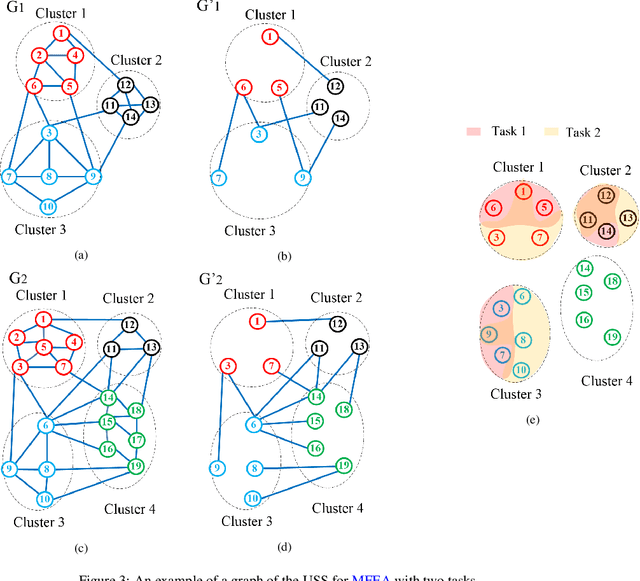

Abstract:The Clustered Shortest-Path Tree Problem (CluSPT) plays an important role in various types of optimization problems in real-life. Recently, some Multifactorial Evolutionary Algorithm (MFEA) have been introduced to deal with the CluSPT, however these researches still have some shortcomings such as evolution operators only perform on complete graphs, huge resource consumption for finding the solution on large search spaces. To overcome these limitations, this paper describes a MFEA-based approach to solve the CluSPT. The proposed algorithm utilizes Dijkstra's algorithm to construct the spanning trees in clusters while using evolutionary operators for building the spanning tree connecting clusters. This approach takes advantage of both exact and approximate algorithms so it enables the algorithm to function efficiently on complete and sparse graphs alike. Furthermore, evolutionary operators such as individual encoding and decoding methods are also designed with great consideration regarding performance and memory usage. We have included a proof on the repairing method's efficacy in ensuring all solutions are valid. We have conducted tests on various types of Euclidean instances to assess the effectiveness of the proposed algorithm and methods. Experiment results point out the effectiveness of the proposed algorithm existing heuristic algorithms in most of the test cases. The impact of the proposed MFEA was analyzed and a possible influential factor that may be useful for further study was also pointed out.
Evolutionary Algorithm and Multifactorial Evolutionary Algorithm on Clustered Shortest-Path Tree problem
Oct 19, 2020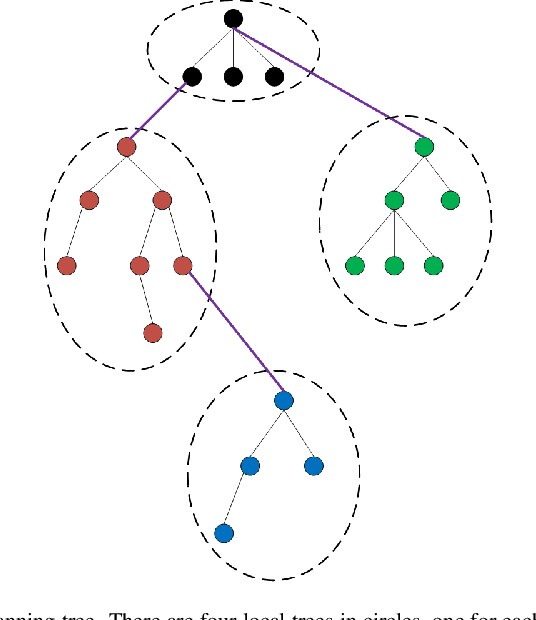
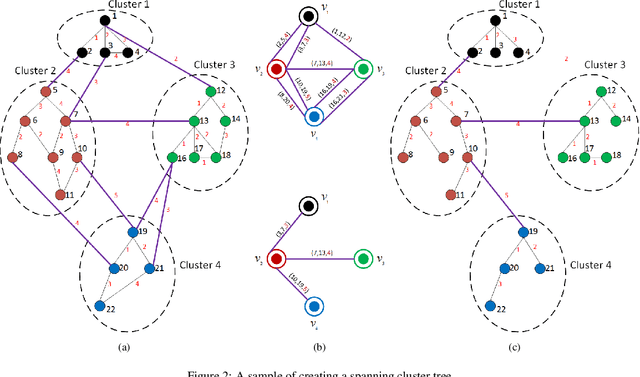

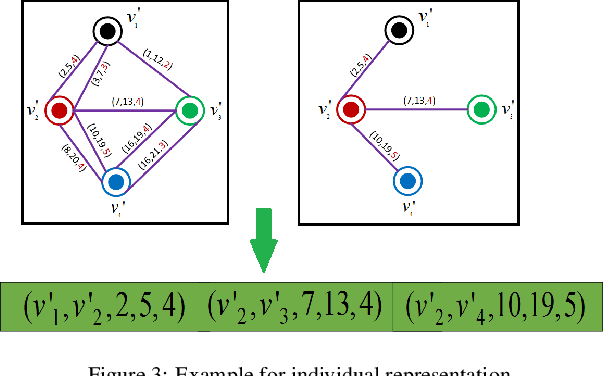
Abstract:In literature, Clustered Shortest-Path Tree Problem (CluSPT) is an NP-hard problem. Previous studies often search for an optimal solution in relatively large space. To enhance the performance of the search process, two approaches are proposed: the first approach seeks for solutions as a set of edges. From the original graph, we generate a new graph whose vertex set's cardinality is much smaller than that of the original one. Consequently, an effective Evolutionary Algorithm (EA) is proposed for solving CluSPT. The second approach looks for vertex-based solutions. The search space of the CluSPT is transformed into 2 nested search spaces (NSS). With every candidate in the high-level optimization, the search engine in the lower level will find a corresponding candidate to combine with it to create the best solution for CluSPT. Accordingly, Nested Local Search EA (N-LSEA) is introduced to search for the optimal solution on the NSS. When solving this model in lower level by N-LSEA, variety of similar tasks are handled. Thus, Multifactorial Evolutionary Algorithm applied in order to enhance the implicit genetic transfer across these optimizations. Proposed algorithms are conducted on a series of datasets and the obtained results demonstrate superior efficiency in comparison to previous scientific works.
A Multifactorial Optimization Paradigm for Linkage Tree Genetic Algorithm
May 06, 2020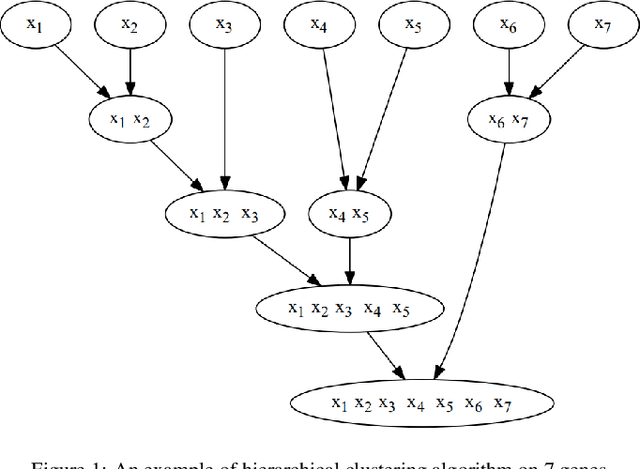
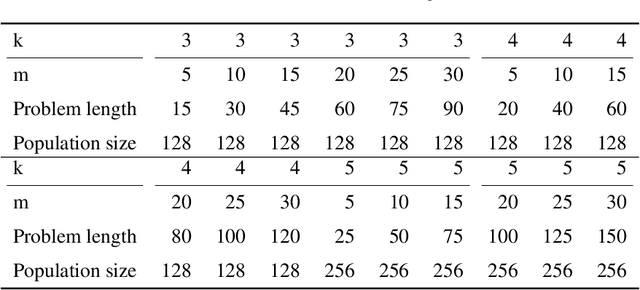
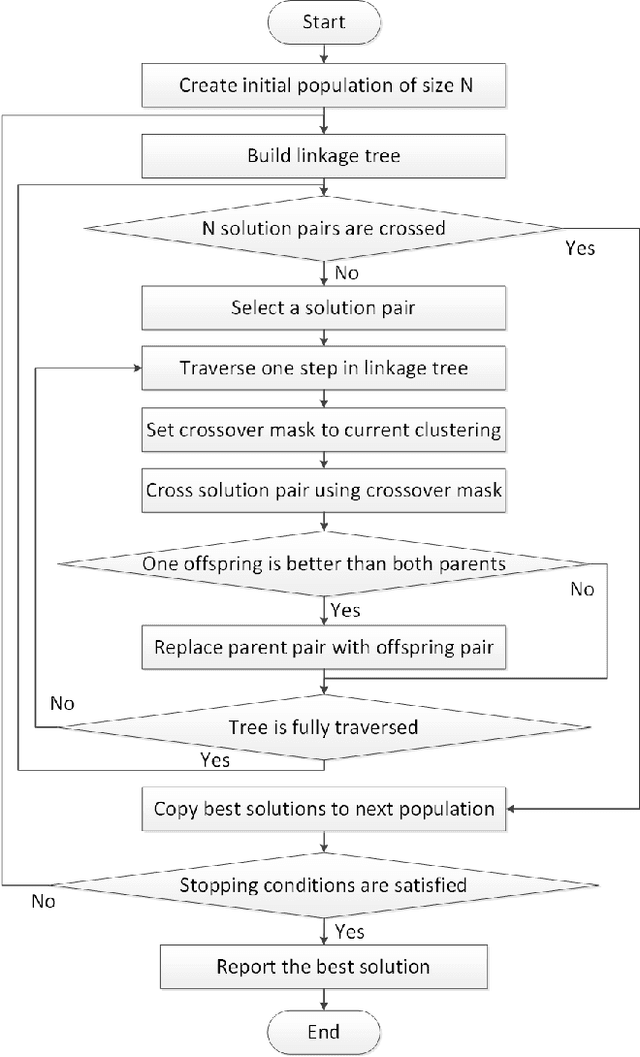
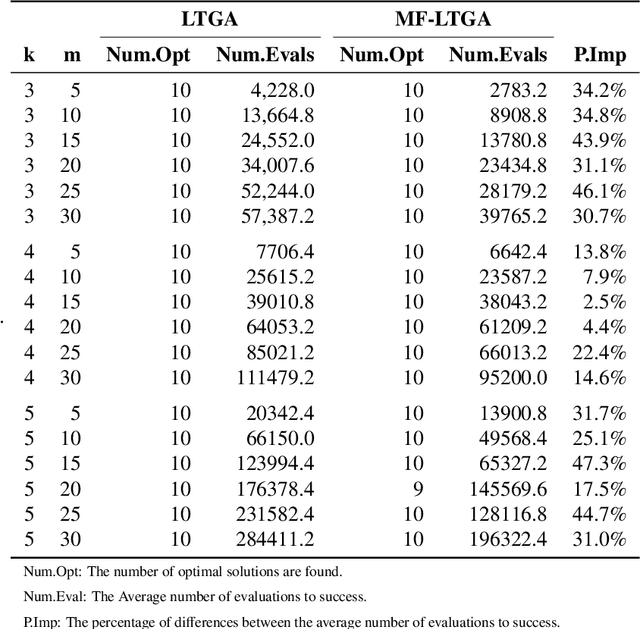
Abstract:Linkage Tree Genetic Algorithm (LTGA) is an effective Evolutionary Algorithm (EA) to solve complex problems using the linkage information between problem variables. LTGA performs well in various kinds of single-task optimization and yields promising results in comparison with the canonical genetic algorithm. However, LTGA is an unsuitable method for dealing with multi-task optimization problems. On the other hand, Multifactorial Optimization (MFO) can simultaneously solve independent optimization problems, which are encoded in a unified representation to take advantage of the process of knowledge transfer. In this paper, we introduce Multifactorial Linkage Tree Genetic Algorithm (MF-LTGA) by combining the main features of both LTGA and MFO. MF-LTGA is able to tackle multiple optimization tasks at the same time, each task learns the dependency between problem variables from the shared representation. This knowledge serves to determine the high-quality partial solutions for supporting other tasks in exploring the search space. Moreover, MF-LTGA speeds up convergence because of knowledge transfer of relevant problems. We demonstrate the effectiveness of the proposed algorithm on two benchmark problems: Clustered Shortest-Path Tree Problem and Deceptive Trap Function. In comparison to LTGA and existing methods, MF-LTGA outperforms in quality of the solution or in computation time.
A Heuristic Based on Randomized Greedy Algorithms for the Clustered Shortest-Path Tree Problem
May 05, 2020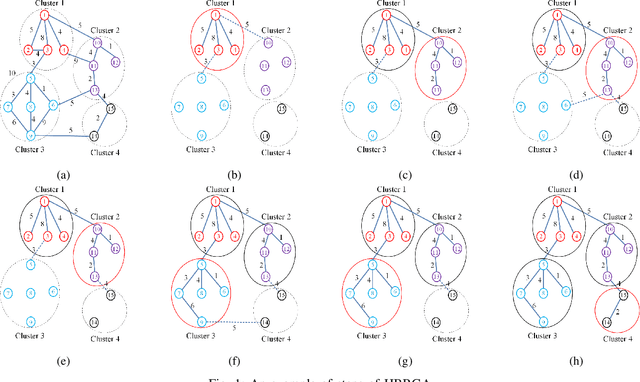
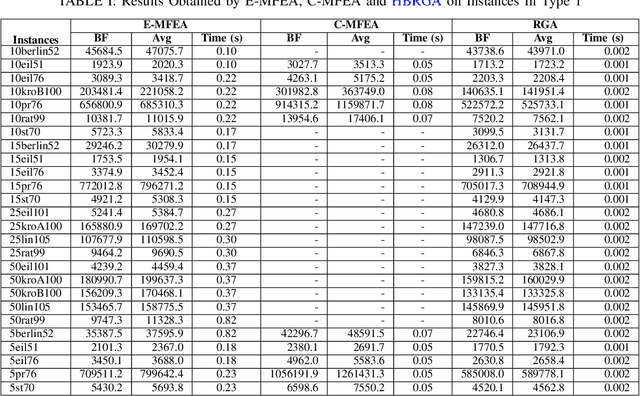
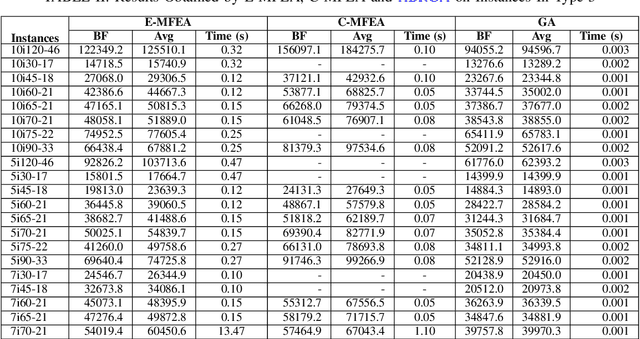
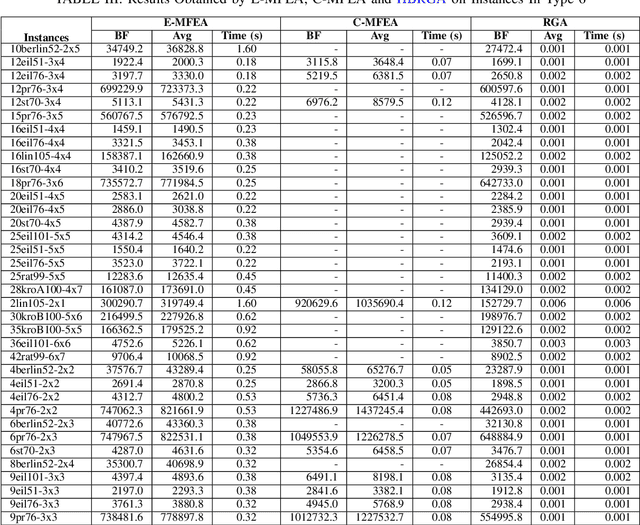
Abstract:Randomized Greedy Algorithms (RGAs) are interesting approaches to solve problems whose structures are not well understood as well as problems in combinatorial optimization which incorporate the random processes and the greedy algorithms. This paper introduces a new algorithm that combines the major features of RGAs and Shortest Path Tree Algorithm (SPTA) to deal with the Clustered Shortest-Path Tree Problem (CluSPT). In our algorithm, SPTA is used to determine the shortest path tree in each cluster while the combination between characteristics of the RGAs and search strategy of SPTA is used to constructed the edges connecting clusters. To evaluate the performance of the proposed algorithm, Euclidean benchmarks are selected. The experimental investigations show the strengths of the proposed algorithm in comparison with some existing algorithms. We also analyze the influence of the parameters on the performance of the algorithm.
New mechanism of combination crossover operators in genetic algorithm for solving the traveling salesman problem
Jan 14, 2020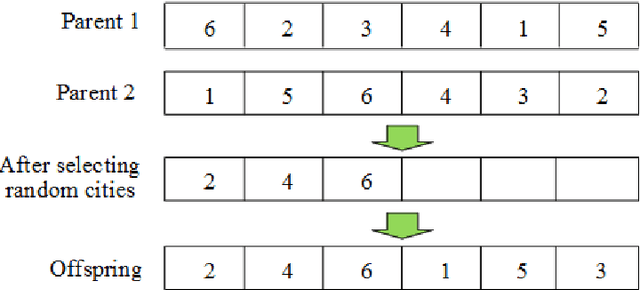
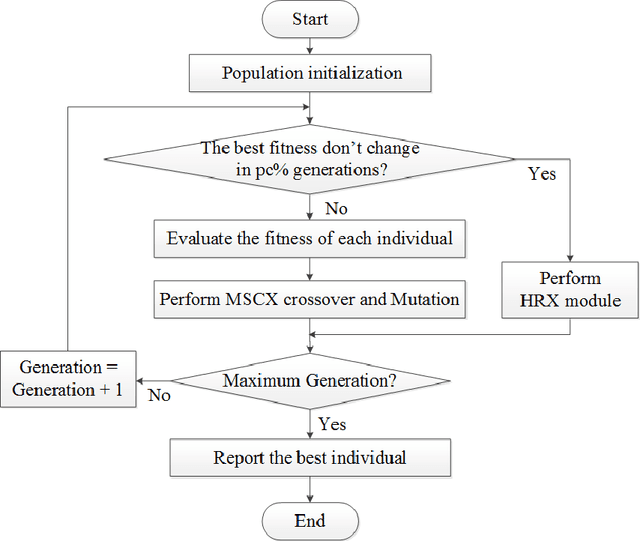
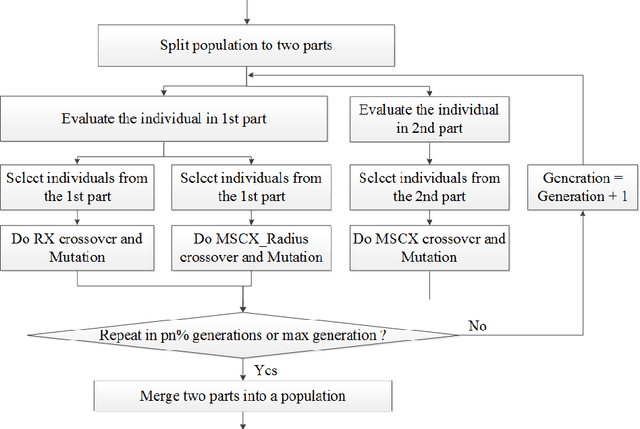
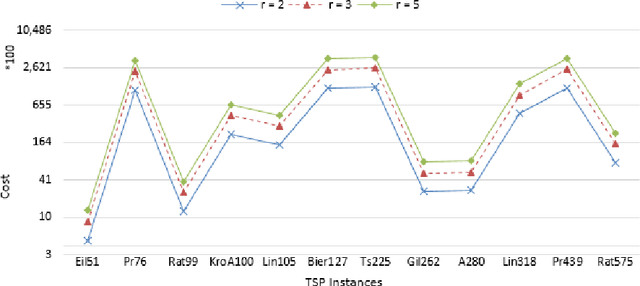
Abstract:Traveling salesman problem (TSP) is a well-known in computing field. There are many researches to improve the genetic algorithm for solving TSP. In this paper, we propose two new crossover operators and new mechanism of combination crossover operators in genetic algorithm for solving TSP. We experimented on TSP instances from TSP-Lib and compared the results of proposed algorithm with genetic algorithm (GA), which used MSCX. Experimental results show that, our proposed algorithm is better than the GA using MSCX on the min, mean cost values.
Multifactorial Evolutionary Algorithm For Clustered Minimum Routing Cost Problem
Dec 23, 2019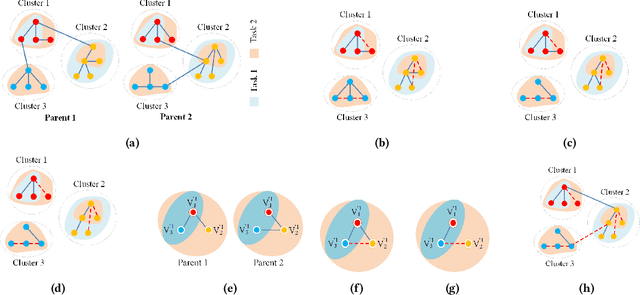


Abstract:Minimum Routing Cost Clustered Tree Problem (CluMRCT) is applied in various fields in both theory and application. Because the CluMRCT is NP-Hard, the approximate approaches are suitable to find the solution for this problem. Recently, Multifactorial Evolutionary Algorithm (MFEA) has emerged as one of the most efficient approximation algorithms to deal with many different kinds of problems. Therefore, this paper studies to apply MFEA for solving CluMRCT problems. In the proposed MFEA, we focus on crossover and mutation operators which create a valid solution of CluMRCT problem in two levels: first level constructs spanning trees for graphs in clusters while the second level builds a spanning tree for connecting among clusters. To reduce the consuming resources, we will also introduce a new method of calculating the cost of CluMRCT solution. The proposed algorithm is experimented on numerous types of datasets. The experimental results demonstrate the effectiveness of the proposed algorithm, partially on large instances
 Add to Chrome
Add to Chrome Add to Firefox
Add to Firefox Add to Edge
Add to Edge